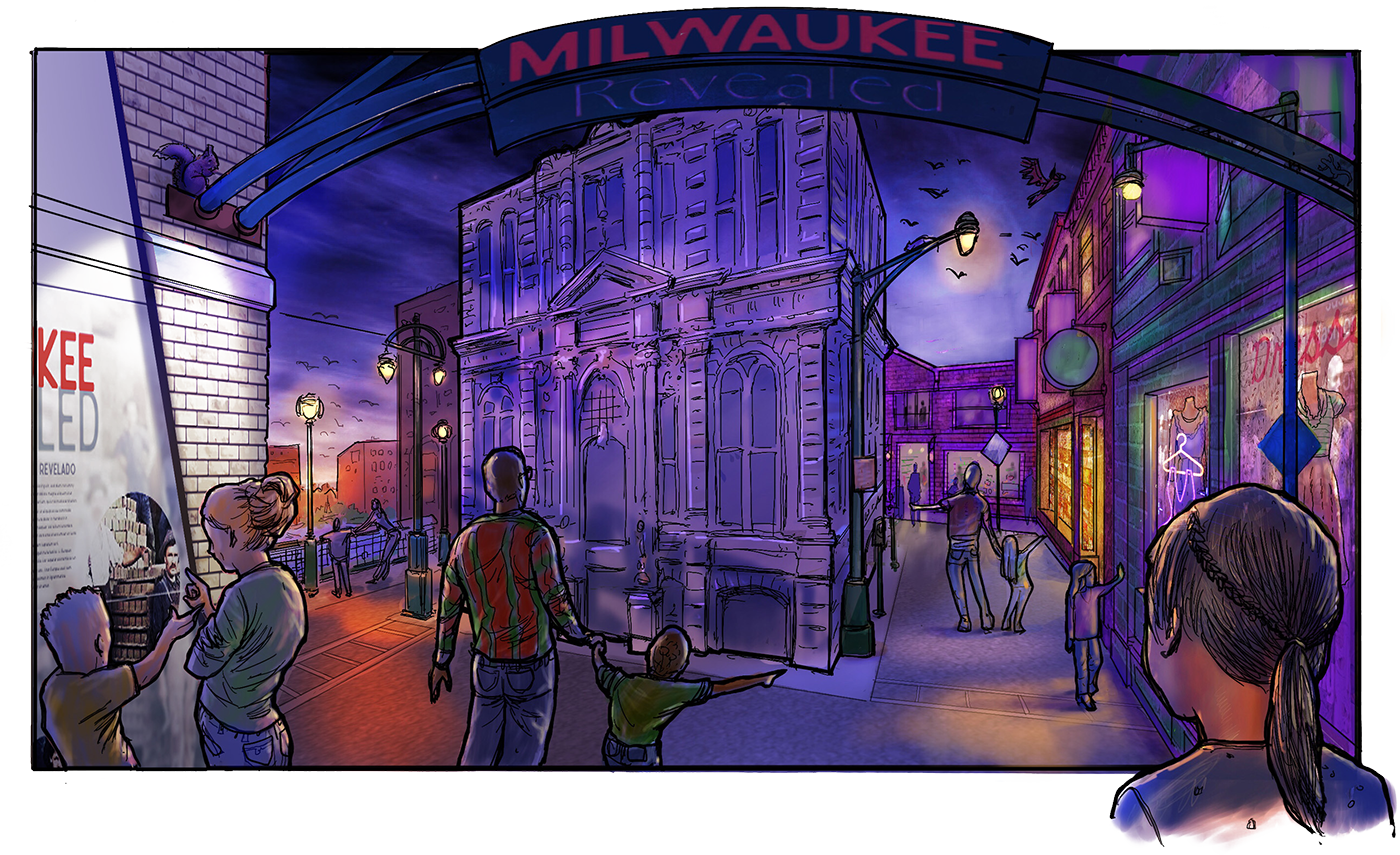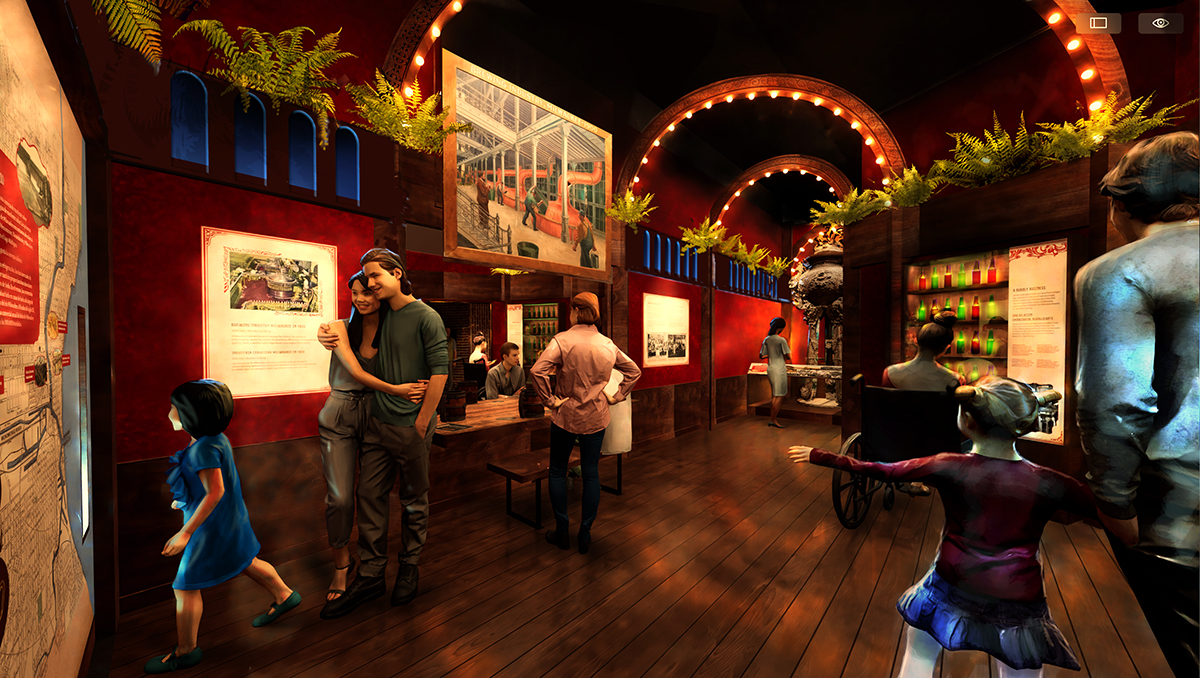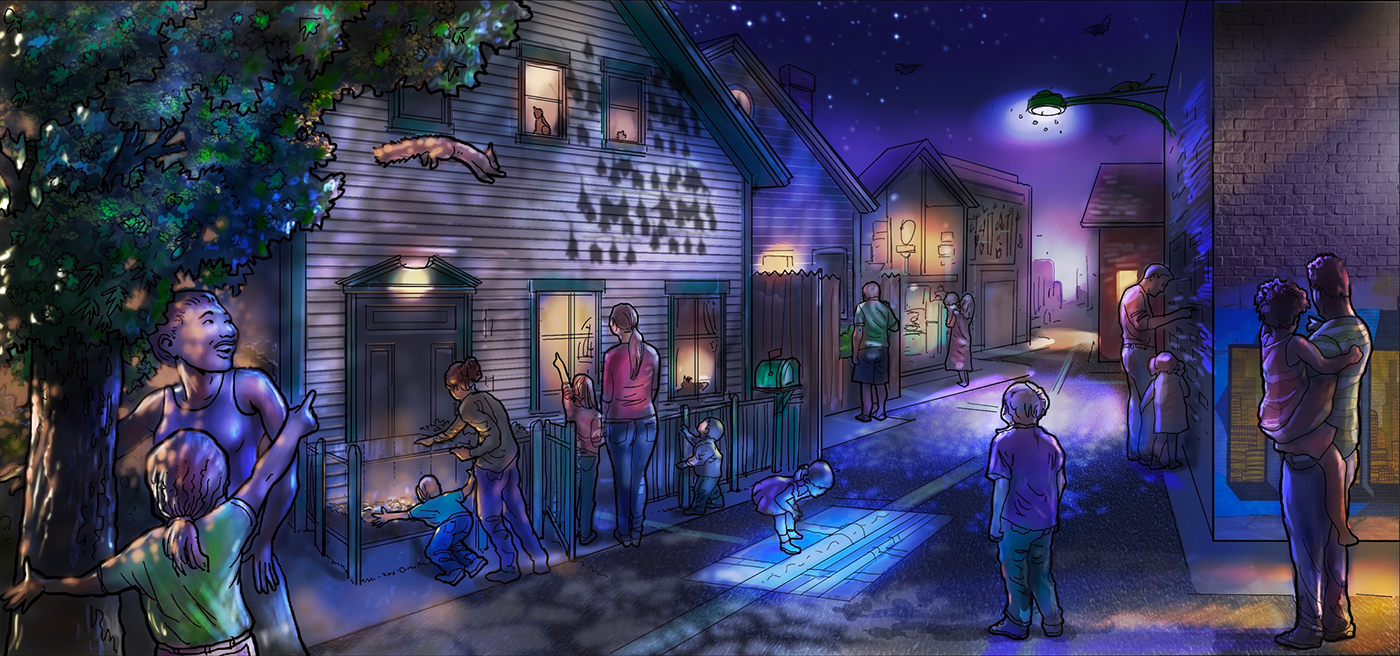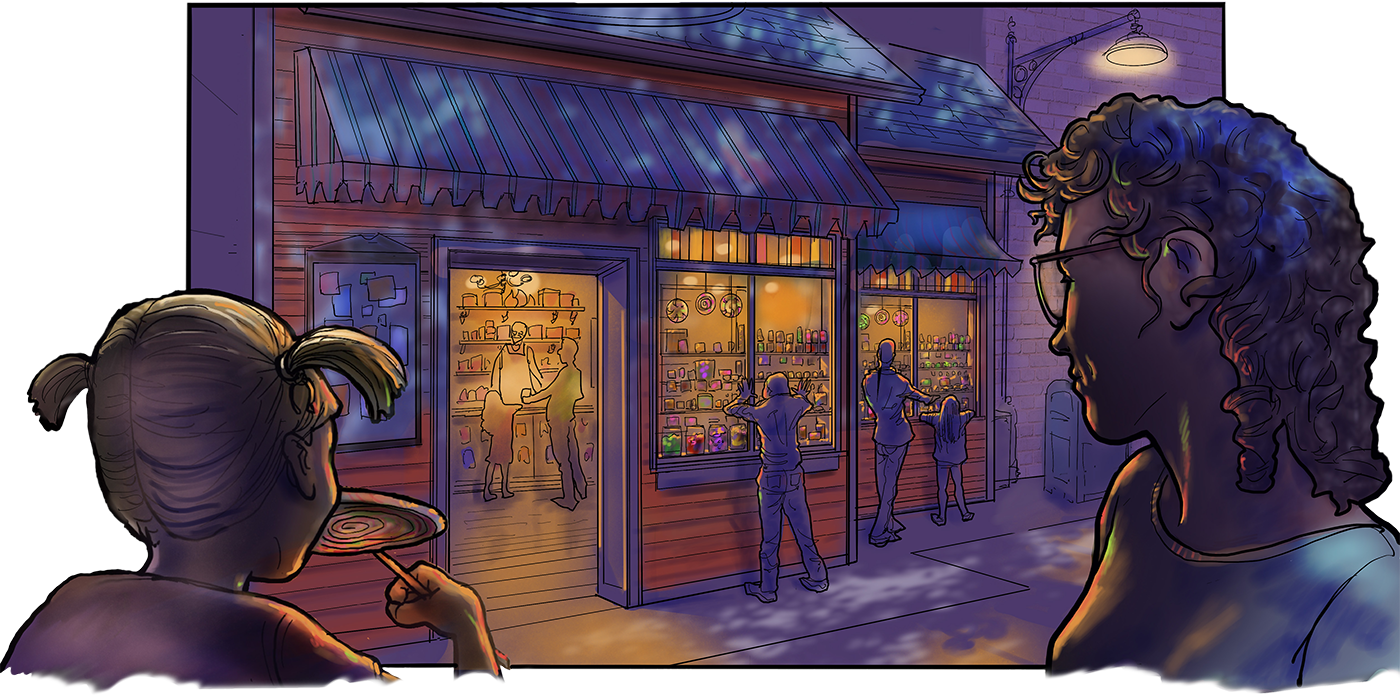


The Milwaukee Revealed gallery explores 300 years of the city's rich history in an immersive walkthrough streetscape exhibit. Set at the magical hour of dusk, the gallery features storefronts, buildings, and houses that visitors can enter where they'll learn new, surprising, and often-overlooked stories about Milwaukee.
Considered the “spiritual successor” to the Streets of Old Milwaukee exhibit at Milwaukee Public Museum, the Milwaukee Revealed gallery will evoke a similar feeling of nostalgia, discovery, and whimsy.


Upon entering the Commercial District of the gallery, visitors will be transported to a bustling, immersive urban environment. A mix of historic and modern city landmarks will reflect a timeless view of Milwaukee.
Mitchell Building
Visitors will first encounter the Mitchell Building, a recognizable, historic building that ties the present to the past. Look long enough and the building's façade will fade away using choreographed lighting effects to reveal the home of city founders Josette and Solomon Juneau, which once occupied the same site.
The Mitchell Building is one of many explorable spaces in Milwaukee Revealed, where visitors will be able to go inside and look at historic artifacts — including a portrait of Josette Juneau currently on display in MPM — and learn the story of the Juneaus' relationship, the Fur Trade, and their role in the founding of the City of Milwaukee as we know it.
Storefronts
Storefronts lining the gallery's streets will give a glimpse into the industries and endeavors that have shaped Milwaukee. Among the shops featured will be a dress shop, where a window display will show a rotating collection of both contemporary and historic textiles from the Museum's vast collections. Inside the shop, visitors will be able to learn about the changing traditions and compositions of clothing from around the world.
Next to the dress shop, visitors will encounter the Culver's custard shop storefront with an exhibit inside that shows how Wisconsin's resources and industries fueled Milwaukee's love for frozen custard and its iconic custard shops. Visitors will be able to enter the exhibit, where they'll smell the sweet scent of freshly baked waffle cones and find a mix of vibrant graphics and historic photographs that reveal stories about how Wisconsin's dairy farmers help supply the ingredients for Milwaukee's frozen custard, how flavors are naturally derived, and how local traditions and materials connect to the rest of the world. They'll even be able to take their turn operating a custard machine that serves an endless loop of faux custard.
Further down the street, a flexible storefront will give Museum staff the opportunity to rotate the collections items on display, revealing a different theme and story for visitors on a regular basis.
Adding to the experience will be urban soundscapes, including the rumble of vehicles and birds chirping, and silhouette projections of people moving inside the gallery's shops and houses.
Cream City Medical Society
Milwaukee Revealed will explore how the many ways of understanding care and practicing medicine have supported Milwaukeeans' health and wellbeing through stories about holistic medicine, disease prevention, and public health.
Central to these stories will be that of the Cream City Medical Society, Milwaukee's first organization of African-American physicians. Visitors will be able to walk into a contemporary pharmacy with an old-timey feel and learn about the different healing and medicine traditions held by Milwaukee's diverse communities and the ways in which plants have been utilized for medicinal purposes across cultures. The pharmacy will be constructed from Cream City brick, and exhibits will explore geological and industrial origins of Milwaukee's iconic building material.
Waterfront
A scenic lookout of the Milwaukee River will give visitors the chance to catch a glimpse of what lies beneath its surface. The city's dropping water table will be visible below the river, and the skyline will change along the riverfront, revealing how the ecology and industry of Milwaukee has evolved over time. Lighting will create a dynamic effect similar to the movement of currents and fish, and a soundscape of rippling water will further immerse visitors into the scene.

Schlitz Palm Garden
Behind the doors of a common, everyday shop, discover the golden years of Milwaukee's beer-brewing kings. This area will answer the question “why beer, why here?” Another immersive space that visitors can enter and explore, the Schlitz Palm Garden, inspired by the famous beer hall with the same name that was built in Milwaukee in 1895, will reveal the story of how German and Polish migration and labor, and access to natural resources like water, wheat, and hops, led to Milwaukee's famed beer production.
Lapham House
Wisconsin's first scientist, Increase Lapham, is a key figure in the development of museums as we know them today. Visitors will be invited to enter a study, much like the one Lapham might have had in his own home, and see a precursor to our modern Museum — with collections of plants and geologic specimens displayed on shelves. A reproduction of his desk will contain examples of his scientific writings, journals, maps, and botanical drawings that have been integral to shaping how museums study and share scientific knowledge today. A projection element will enlarge those writings and drawings on the wall so visitors can see in greater detail the breadth of what Lapham created and established. Reproductions of fossils and specimens will also be accessible for visitors to touch and interact with like scientists themselves.
Lakefront
Tying the Commercial District to the Neighborhoods area of the gallery will be an immersive exhibit that explores how Lake Michigan has been integral to serving both the business and residential aspects of Milwaukee.


Milwaukee is a network of neighborhoods and neighbors: Plants, animals, and humans intertwine to support one another, often in unexpected ways. The Neighborhoods area will recreate a quintessential Milwaukee neighborhood street, mimicking domestic architecture commonly found in the city while also offering surprising details and the kind of “Easter eggs” Museum fans love to discover.
Community Streetscape
Houses lining the street will explore more than meets the eye. The gallery's streetscape will reveal stories about the hidden systems that make modern living possible, such as the water and sewage systems that underlie all of Milwaukee. In other houses, visitors might glimpse animals like bats and squirrels that coexist with humans in the city and play an important role in our urban ecosystem. In a community garden, visitors will encounter live specimens of familiar garden creatures like spiders, ladybugs, and other urban neighbors who live in and contribute to nature within the city.

Haymarket Candy Shop
Visitors will find a taste of the familiar: The Haymarket Candy Shop, which is a beloved storefront in the Streets of Old Milwaukee, will be a functioning store in the Future Museum where shoppers can purchase a sweet treat. This Museum tradition also honors the new building's location in the Haymarket neighborhood, and exhibits will explore the Haymarket's history in Milwaukee.
Signature Museum Items
Several signature items on exhibit in Streets, like the penny-farthing bicycle and the one-of-a-kind Schloemer automobile will be on display in this gallery, as well as the giant Japanese censer — or incense burner — which once stood in the real Schlitz Palm Garden and is currently on display in MPM's Sense of Wonder exhibit.


